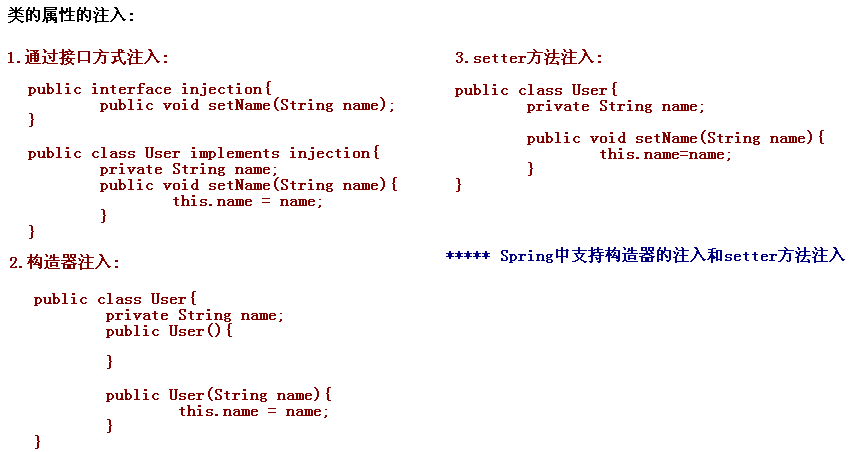Spring框架Bean实例化的方式
提供了三种方式实例化Bean
构造方法实例化(默认无参数,用的最多)
静态工厂实例化
实例工厂实例化
无参数构造方法的实例化
<!-- 默认情况下使用的就是无参数的构造方法. --> <bean id="bean1" class="cn.yzu.spring3.demo2.Bean1"></bean>
静态工厂实例化
public class Bean2Factory { public static Bean2 getBean2(){ System.out.println("静态工厂的获得Bean2的方法..."); return new Bean2(); } }
<!-- 第二种使用静态工厂实例化 --> <bean id="bean2" class="cn.yzu.spring3.demo2.Bean2Factory" factory-method="getBean2"></bean>
实例工厂实例化
public class Bean3Factory { public Bean3 getBean3(){ System.out.println("Bean3实例工厂的getBean3方法..."); return new Bean3(); } }
<!-- 第三种使用实例工厂实例化 --> <bean id="bean3" factory-bean="bean3Factory" factory-method="getBean3"></bean> <bean id="bean3Factory" class="cn.yzu.spring3.demo2.Bean3Factory"/>
Bean的其他配置
id和name的区别
id遵守XML约束的id的约束.id约束保证这个属性的值是唯一的,而且必须以字母开始,可以使用字母、数字、连字符、下划线、句话、冒号,name没有这些要求
如果bean标签上没有配置id,那么name可以作为id.现在的开发中一般都使用id
类的作用范围
scope属性
singleton :单例的.(默认的值.)
prototype :多例的.
request :web开发中.创建了一个对象,将这个对象存入request范围,request.setAttribute();
session :web开发中.创建了一个对象,将这个对象存入session范围,session.setAttribute();
globalSession :一般用于Porlet应用环境.指的是分布式开发.不是porlet环境,globalSession等同于session;
实际开发中主要使用singleton,prototype
Bean的生命周期
配置Bean的初始化和销毁的方法
init-method=”setup”
destroy-method=”teardown”
执行销毁的时候,必须手动关闭工厂,而且只对scope=”singleton”有效.
Bean的生命周期的11个步骤
1.instantiate bean对象实例化
2.populate properties 封装属性
3.如果Bean实现BeanNameAware 执行 setBeanName
4.如果Bean实现BeanFactoryAware 或者 ApplicationContextAware 设置工厂 setBeanFactory 或者上下文对象 setApplicationContext
5.如果存在类实现 BeanPostProcessor(后处理Bean) ,执行postProcessBeforeInitialization
6.如果Bean实现InitializingBean 执行 afterPropertiesSet
7.调用<bean init-method="init"> 指定初始化方法 init
8.如果存在类实现 BeanPostProcessor(处理Bean) ,执行postProcessAfterInitialization
9.执行业务处理
10.如果Bean实现 DisposableBean 执行 destroy
11.调用<bean destroy-method="customerDestroy"> 指定销毁方法 customerDestroy
演示(在CustomerService类的add方法之前进行权限校验)
public interface CustomerService { public void add(); public void find(); }
public class CustomerServiceImpl implements CustomerService, BeanNameAware,ApplicationContextAware,InitializingBean,DisposableBean { private String name; public void setName(String name) { System.out.println("第二步:属性的注入."); this.name = name; } public CustomerServiceImpl() { super(); System.out.println("第一步:实例化类."); } public void add(){ System.out.println("添加客户..."); } public void find(){ System.out.println("查询客户..."); } public void setBeanName(String name) { System.out.println("第三步:注入配置的类的名称"+name); } public void setApplicationContext(ApplicationContext applicationContext) throws BeansException { System.out.println("第四步:注入applicationContext"+applicationContext); } public void afterPropertiesSet() throws Exception { System.out.println("第六步:属性设置后执行..."); } public void setup(){ System.out.println("第七步:调用手动设置的初始化方法..."); } public void destroy() throws Exception { System.out.println("第十步:调用销毁的方法..."); } public void teardown(){ System.out.println("第十一步:调用手动销毁方法..."); } }
public class MyBeanPostProcessor implements BeanPostProcessor{ /** * bean:实例对象 * beanName:在配置文件中配置的类的标识. */ public Object postProcessBeforeInitialization(Object bean, String beanName) throws BeansException { System.out.println("第五步:初始化之前执行..."); return bean; } public Object postProcessAfterInitialization(final Object bean, String beanName) throws BeansException { System.out.println("第八步:初始化后执行..."); // 动态代理: if(beanName.equals("customerService")){ Object proxy = Proxy.newProxyInstance(bean.getClass().getClassLoader(), bean.getClass().getInterfaces() , new InvocationHandler() { // 调用目标方法的时候,调用invoke方法. public Object invoke(Object proxy, Method method, Object[] args) throws Throwable { if("add".equals(method.getName())){ System.out.println("权限校验..."); Object result = method.invoke(bean, args); //System.out.println(System.currentTimeMillis()); return result; } return method.invoke(bean, args); } }); return proxy; } return bean; } }
public class SpringTest4 { @Test // Bean完整的生命周期 public void demo1() { ClassPathXmlApplicationContext applicationContext = new ClassPathXmlApplicationContext("applicationContext.xml"); CustomerService customerService = (CustomerService) applicationContext.getBean("customerService"); customerService.add(); customerService.find(); applicationContext.close(); } }
运行结果:

Bean中属性注入

构造器注入
<bean id="car" class="cn.yzu.spring3.demo5.Car"> <!-- <constructor-arg name="name" value="宝马"/> <constructor-arg name="price" value="1000000"/> --> <constructor-arg index="0" type="java.lang.String" value="奔驰"/> <constructor-arg index="1" type="java.lang.Double" value="2000000"/> </bean>
setter方法注入
<bean id="car2" class="cn.yzu.spring3.demo5.Car2"> <!-- <property>标签中name就是属性名称,value是普通属性的值,ref:引用其他的对象 --> <property name="name" value="保时捷"/> <property name="price" value="5000000"/> </bean> <bean id="person" class="cn.yzu.spring3.demo5.Person"> <property name="name" value="任童"/> <property name="car2" ref="car2"/> </bean>
名称空间p注入属性
Spring2.5版本引入了名称空间p
p:<属性名>="xxx" 引入常量值
p:<属性名>-ref="xxx" 引用其它Bean对象
引入名称空间
<beans xmlns="http://www.springframework.org/schema/beans" xmlns:p="http://www.springframework.org/schema/p" xmlns:xsi="http://www.w3.org/2001/XMLSchema-instance" xsi:schemaLocation=" http://www.springframework.org/schema/beans http://www.springframework.org/schema/beans/spring-beans.xsd">
<bean id="car2" class="cn.yzu.spring3.demo5.Car2" p:name="宝马" p:price="400000"/> <bean id="person" class="cn.yzu.spring3.demo5.Person" p:name="童童" p:car2-ref="car2"/>
SpEL:属性的注入
Spring3.0提供注入属性方式
语法:#{表达式} <bean id="" value="#{表达式}">
<bean id="car2" class="cn.yzu.spring3.demo5.Car2"> <property name="name" value="#{'大众'}"></property> <property name="price" value="#{'120000'}"></property> </bean> <bean id="person" class="cn.yzu.spring3.demo5.Person"> <!--<property name="name" value="#{personInfo.name}"/>--> <property name="name" value="#{personInfo.showName()}"/> <property name="car2" value="#{car2}"/> </bean> <bean id="personInfo" class="cn.yzu.spring3.demo5.PersonInfo"> <property name="name" value="张三"/> </bean>
集合属性的注入
<bean id="collectionBean" class="cn.yzu.spring3.demo6.CollectionBean"> <!-- 注入List集合 --> <property name="list"> <list> <value>童童</value> <value>小凤</value> </list> </property> <!-- 注入set集合 --> <property name="set"> <set> <value>杜宏</value> <value>如花</value> </set> </property> <!-- 注入map集合 --> <property name="map"> <map> <entry key="刚刚" value="111"/> <entry key="娇娇" value="333"/> </map> </property> <property name="properties"> <props> <prop key="username">root</prop> <prop key="password">123</prop> </props> </property> </bean>
加载配置文件
一种写法:ApplicationContext applicationContext = new ClassPathXmlApplicationContext("bean1.xml",”bean2.xml”);
二种方法:<import resource="applicationContext2.xml"/>